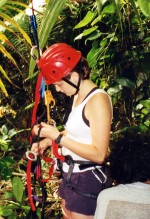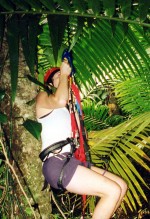Plant physiologists and ecologists alike long to understand the exchange processes of tree canopies at different spatial locations. But repeated, nondestructive, in situ measurements have been difficult to obtain. Walkup towers are time-consuming to construct and access is limited to the trees in their immediate vicinity, while canopy cranes are expensive and impractical to operate in areas with rugged topography. Nancy Harris is a Ph.D. student in Dr. Charles Hall’s ecological modeling group at SUNY College of Environmental Science and Forestry (SUNYESF) in Syracuse, NY. Harris has chosen to implement a unique method that allows access to virtually any tree in any forest, regardless of topography.
By hanging from a branch in the canopy using technical rock climbing equipment, she can choose from a wider variety of survey sites, trees, and canopy heights than those working from fixed towers. This rope-climbing method has been used in the past primarily for the construction of new canopy towers and walkways, but has been applied less frequently in the context of ecological research.
Rigging a tree to climb can take as little as an hour. A giant slingshot is used to shoot a 3-oz. fishing weight attached to 12-lb. test fishing line over a branch high in the canopy. Once the line is over the branch, it is replaced first with parachute cord and then with a 12-mm diameter technical rockclimbing rope that can be climbed using a harness and mechanical ascenders. A separate pulley system is rigged so that by pulling a rope from ground level, the photosynthesis machine can be raised or lowered to any height desired.
Empirical data on the carbon sequestering abilities of tropical forests are scarce, yet they might prove to be critically important for balancing the global carbon budget. Many regional models of forest productivity exist, such as that of Wang et al. (2003) for the Luquillo Experimental Forest (LTER LUQ), Puerto Rico [Forest Ecology and Management 179: 69- 94]. However, this and many other models often use generalized parameters and equations to simulate exchange processes without ever testing or otherwise validating results with site-specific information.
As part of her dissertation work, Harris is testing the validity of Wang’s forest productivity model by gathering physiological data on the gas exchange of leaf, trunk, and soil surfaces at 13 georeferenced locations situated along an elevational gradient in the Luquillo Forest. She has measured the photosynthetic rates of both canopy and understory leaves of different tree species as well as rates of trunk and soil respiration using a portable photosynthesis machine and soil chamber (model 6400, LI-COR, Inc. Lincoln, NE). Currently, Harris is combining these measurements with climate modeling techniques in order to compute carbon budgets for specific ‘columns’ of the forest, which will then be extrapolated in order to evaluate how values of gross primary production (GPP), respiration and net primary production (NPP) vary over both time and space. In addition to model validation, Harris’s measurements also serve as a type of groundtruthing for satellite image analysis.
The evaluation of global- and regional-scale carbon models requires adequate field parameterization of plant-atmosphere exchange processes. Through the use of new and unique field methods, these measurements and understanding of ecological and physiological processes can now be evaluated over both time and space.

 Enlarge this image
Enlarge this image
